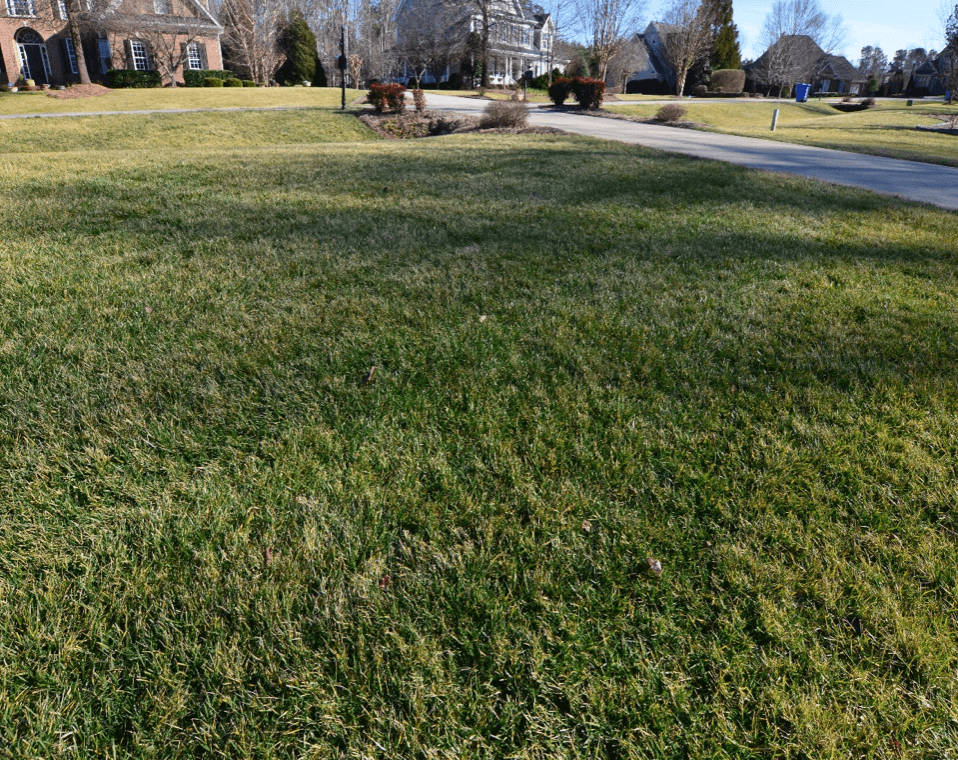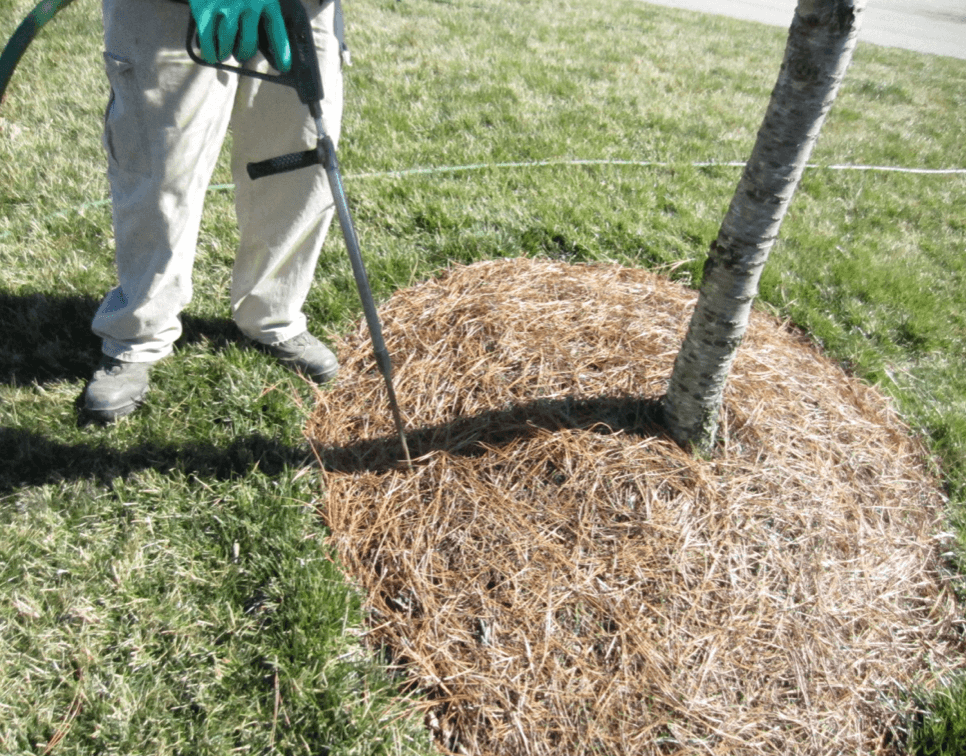Pre-Emergent Crabgrass Control Crabgrass will usually start to germinate in late March or early April throughout the Transitional Zone. However, Germination could be early this year due to the increase in current ground temperatures. Germination will occur when soil temperatures are about 53 degrees and 3 to 4 inches deep. Crabgrass germination will be seen… Read more »

Crabgrass will usually start to germinate in late March or early April throughout the Transitional Zone. However, Germination could be early this year due to the increase in current ground temperatures. Germination will occur when soil temperatures are about 53 degrees and 3 to 4 inches deep. Crabgrass germination will be seen first in bare spots with little desirable turf and in full sun. The first application must be completed before Crabgrass starts to germinate. It is always best to control Crabgrass, when possible, before it germinates. Controlling it once it matures is often difficult. Fairway Green utilizes a three application pre-emergent process to offer the best summer Crabgrass control possible. This process is used based on local research from NC State University.
Pre-emergent starts to break down around mid-July. The pre-emergent breaks down so fescue seeding can start around the end of August. Early Crabgrass breakthrough, after proper pre-emergent applications, can be contributed to low mowing heights, thin areas in the lawn and aggressive edging along sidewalks and driveways.
Winter annual weeds can be prolific this time of year. These weeds germinate in the fall, grow through the winter months, and reproduce in the spring. The most appropriate time to treat these weeds is when they are young and actively growing. They become difficult to control once they start to flower.

Broadleaf weed control could be difficult this spring due to many Fescue lawns being thin and not completely tillered. Tiller simply means the fescue plant adds additional leaf blades thickening the plant and increasing the ability to compete against broadleaf weeds. In addition, sometimes less effective post-emergent weed controls need to be used to decrease the chance of injuring the immature grass. The more difficult weeds will be controlled once the turf matures enough to handle the more aggressive weed controls.
Research has proven that maintaining a mowing height of 3½” – 4” on fescue drastically reduces the amount of crabgrass in the lawn. Mowing at this height will also help promote healthy turf and help control broadleaf weeds.
Poa Annua (annual Blugrass) and Poa trivialis (rough Bluegrass) have been very active this year.

Poa annua (annual Bluegrass) is a common winter annual grassy weed in all turf types. Poa annua is one of the more frustrating weeds in home lawns from November to May. It will be found in all turf types. It is easily seen in warm-season turf during the winter because the turf is dormant while Poa annua is green and actively growing. However, most people with fescue turf do not realize they have it until late spring when the Poa annua produces tan-colored seed heads and the leaf blades turn an off green.
Poa annua (annual Bluegrass) control in Fescue, is extremely difficult. It requires two (2) applications of a special product in November, then again in December. Both must be completed and they need to be completed roughly 30 days apart. This will only control 70% to 75% of the potential Poa annua germination. This application process will not eliminate or control 100% of the possible Poa annua. Due to excessive product cost, applications are an addition to regular service at the same application price per application.
Please contact us through the customer portal or visit FairwayGreen.com to request service.
Poa annua control in Bermuda and Zoysia is completed in the fall from October to December. It is a special warm-season turf product, different from the cool season product that is applied roughly 30 days apart. This will provide roughly the same level of control as the fescue product. You can expect 75% to 80% control after these two applications. This product is included with your regular Round Five and Round Six applications

Poa trivialis (rough Bluegrass) is a perennial cool-season grass. It has a light green color and stands out in most desired turfgrass. It forms a dense spreading mat usually seen in the spring, fall and winter. Poa trivialis does not tolerate heat and full sun well and will go dormant and appear to disappear in the summer. However, it will return when the temperatures cool.
Poa trivialis is very difficult to control in fescue. There a few products that are showing some promise but still in the trial stages. These combination products are also very costly making the treatment costly.
The best control at this point is to maintain good quality turf and density. Applying a non-selective weed control prior to seeding in fall can be a good method of control.

Fescue turf may have received desiccation of the leaf tissue during the winter months (a yellow or brownish color on the leaf blade). Frost damage causes the tips of the blade to turn yellow, giving the lawn an overall yellow color. This is caused when the moisture in the grass blades freezes and ruptures the cells at the tip of the blades. This will grow out and be cut off with mowing as spring arrives and temperatures become more favorable for Fescue growth. An increase in temperatures along with the early spring application will help the plant recover and flourish. However, there are a few turf diseases in the winter that could also be the cause.
Try to leave Fescue a little taller going into winter. This will provide a slightly longer desiccated leaf tip to be cut off on your first cutting giving the lawn a greener start in the spring.

Warm season turf like Bermuda, Zoysia and especially Centipede can sustain damage during the winter in the Transition Zone. This can occur from extended periods of very cold air and ground temperatures or one or a few very cold nights in the teens. These types of grasses are grown in warm often full sun areas of the country and do not have the ability to survive the conditions mentioned above. However, excellent breeding programs have given us varieties that are able to handle difficult climatic conditions much better. This does not mean they are immune to injury or damage.
Conditions that increase the possibility for winter injury/damage:

Time is running out to take advantage of Deep Root Fertilization on ornamental trees and shrubs, which is a key horticultural practice for overall tree and shrub health. A probe is inserted into the feeder root zone and releases a slow-releasing fertilizer with Iron. This is done in late winter or very early spring. Only one application, when utilizing the proper rate, is needed to feed the plant through the entire growing season. Many people feel if they feed their valuable ornamentals they will grow more vigorously. However, this is not the case with this type of fertilization. This long chain fertilizer acts more like a nutritional vitamin for your plant not a growth stimulator. This will help the plant recover from winter stress along with natural insect and disease resistance.

February and March are great times to prune your Crepe Myrtles. Avoid pruning much past March. Many people prune Crepe Myrtles incorrectly. The proper way is to trim only the braches that are rubbing or crossing other branches and to improve the natural form. Pruning a Crepe Myrtle is meant to enhance the natural appearance and growth of the individual tree, not to produce more flowers. Many people cut off the top of the branches leaving a stump appearance to the tree; known as topping. This creates several non-productive and supportive branches on the tree. These branches are weak, often producing late and or shorter bloom times and can weaken the overall health of the tree in time.
A few other ornamentals to prune now: Many varieties of Camelia, Rose of Sharron, Butterfly Bush and Nandina.
Time is running out to save 7% on your annual programs. This is an excellent opportunity to save 7% on your annual programs. Thank you for your business!
In our continued effort to improve and deliver the best possible turf and ornamental management service, we will be moving to a more efficient method of communication. Fairway Green will be implementing an email/text notification system in the coming months. The notification will be used for invoicing after service and important alerts/notifications pertaining to your services. This new notification system will help us service your lawn in the most efficient and effective way possible. This method will also help reduce our environmental impact on landfills and recycle centers by eliminating paper and clear plastic bag waste.
We plan on moving to the new system by mid-2020 or sooner. Please help make this transition as smooth as possible and update/correct your cell numbers and email addresses in our system.